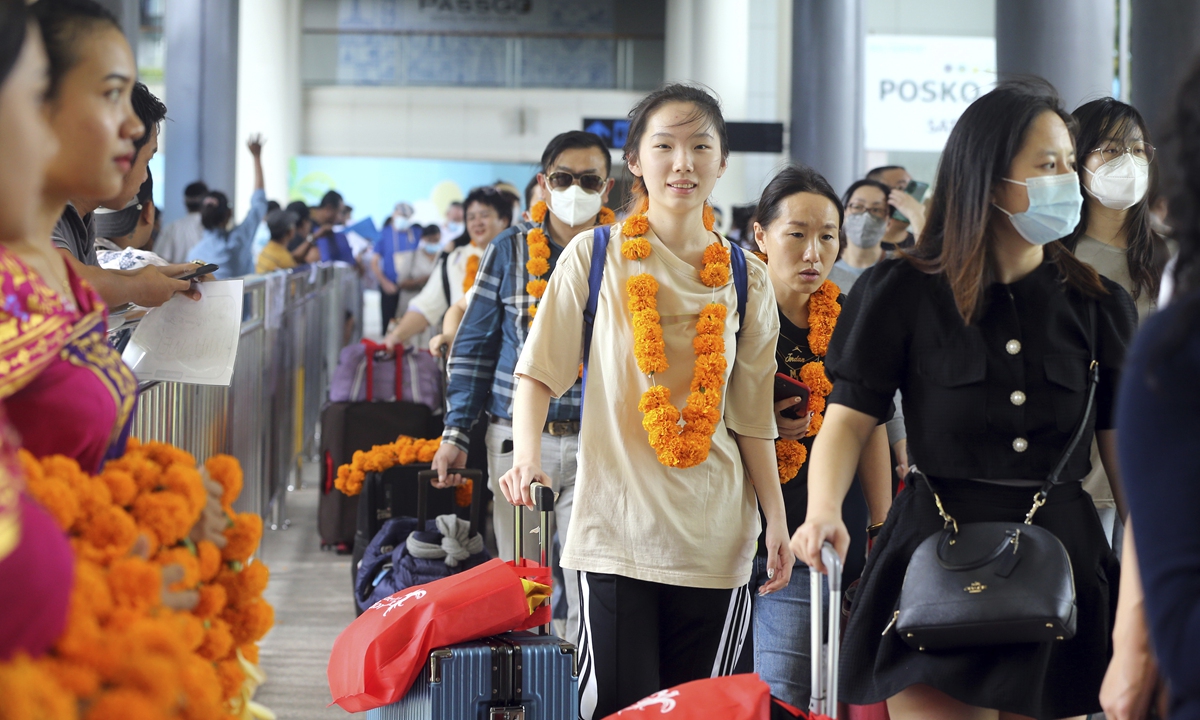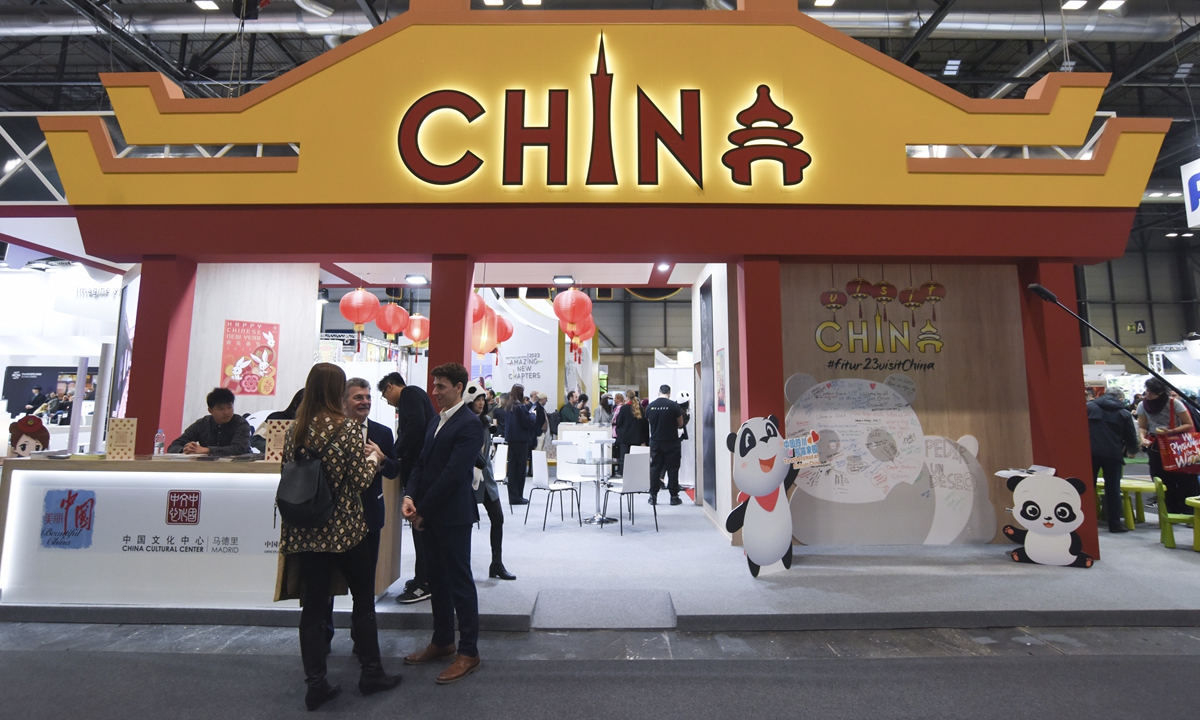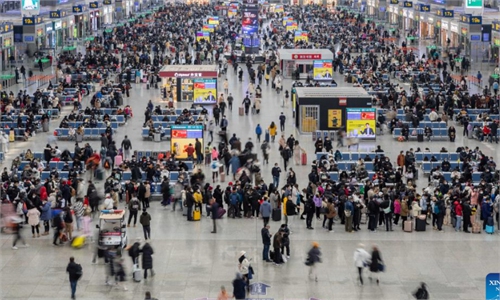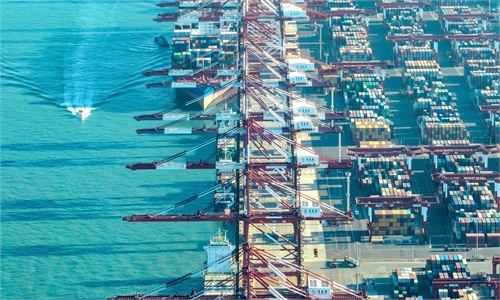
Chinese tourists arrive at Ngurah Rai International Airport in Bali, Indonesia on January 22, 2023. Photo: VCG
People visit China's stand at the International Tourism Fair, Fitur 2023, at Ifema Madrid held in Madrid, Spain, on January 18, 2023.Photo: VCG
After three years of the COVID-19 pandemic, global businesses were glad to see Chinese visitors once again arriving at their local tourist attractions and shopping malls over the just concluded Spring Festival holidays and Lantern Festival.
China has resumed agency-led outbound tour groups on Monday. In the early morning of Monday, at Shanghai's Pudong International Airport, the Global Times reporter witnessed the excitement of a 24-member tour group ready to fly to Thailand for a six-day trip. The recovery of Chinese outbound tourism has injected strong vitality to overseas tourism and consumer markets, industry insiders commented.
While the mainstream international community has welcomed China's optimized domestic COVID-19 response, and embraced its increasing external exchanges and communications, a few people in the West are, however, trying to hinder China from further connecting to the world.
Apart from the highly criticized entry restrictions imposed by several countries reportedly targeting Chinese visitors, observers have seen some Western media outlets pointing fingers at China's COVID policies. They claim that the optimized measures implemented by the country, which intend to better connect the globe, may instead lead to the country's "disconnection" or "isolation" from the world.
Behind such ridiculous claims, some Western media sources, by fear-mongering that inbound Chinese visitors may cause new infection waves locally, have attempted to depict China's recent COVID policy move as "unwelcome" and "unaccepted," analysts told the Global Times.
In sharp contrast to the Western sources' accusations, China has been in close contact with the world in various fields in recent years, and now the COVID policy optimization is bringing better opportunities for further cooperation. Many Chinese and foreign nationals reached by the Global Times said they are actively resuming exchanges.
"The Western media's coverage of China is mainly negative, but we business people are not media guys; we are rational," said textile exporter Xu Yihong, who flew to Japan to negotiate with Japanese clients in December 2022 with the help of the Chinese local government.
"No matter what they (Western media sources) have said, we continue to focus on facts," Xu told the Global Times. "My international clients and I maintain excellent communication."
Embrace the world
From government officials to busy businesspersons to culture and art industry practitioners, China has been actively embracing the world in various fields while overcoming the difficulties brought about by a global pandemic.
Many outbound group tours are reported to have since been fully booked soon after the government announced the pilot resumption of agency-led outbound tour groups. A 10-day tour to New Zealand which costs about 26,000 yuan ($3,837) per person, for instance, was sold out in only one minute after it was put on sale last week, thepaper.cn reported on Monday.
Data shows that during this year's Spring Festival, or Chinese New Year, immigration management agencies across China inspected 1.443 million people who left the country, a 117.8 percent surge year-on-year.
Outbound Chinese tourists showed their strong buying power in this first week-long holiday after COVID policy optimization, as the transaction amount of domestic consumers using UnionPay cards at overseas ATMs and merchants grew by some 60 percent, the Beijing Youth Daily reported on January 30.
Domestically, after China optimized its COVID policy, authorities then conducted one-on-one visits to foreign enterprises and business associations to collect their responses, said the Chinese Ministry of Commerce on January 6.
At a thematic briefing on January 10, officials from sectors including healthcare, commerce, customs, immigration, and civil aviation explained China's new COVID policy to more than 120 foreign enterprises and business associations from over 30 countries, and provided answers to related questions, such as "how does China monitor the virus' mutation" and "when will direct flights between China and the US resume."
"Foreign businessmen that we know welcome the new opening policy," Loh Wee Keng, chairman of the Malaysian Chamber of Commerce and Industry in China, told the Global Times at the briefing. "There are a lot of companies that really can't wait to invest in China."
At regional governments, officials work hard to help local exporters reconnect with overseas clients offline as soon as possible.
On December 4, 2022, days before China officially announced the optimization of the COVID policy, 48-year-old textile exporter Xu Yihong had arrived in Japan along with dozens of her peers. They are from Jiaxing, East China's Zhejiang Province.
By taking a charter flight provided by the Jiaxing government, the exporters were able to attend Asia Fashion Fair there to seek new Japanese clients who were out of reach in the three years of the global pandemic.
Xu owns a textile company in Jiaxing. Before the global pandemic, more than 90 percent of her orders were from Japan. The pandemic brought great losses for her company because of previous entry and exit restrictions, but fortunately the hard days seem to have come to an end.
"This time in Japan, I talked to potential buyers face to face and got many intent orders," Xu told the Global Times after returning to China. "I appreciate the government's efforts in sending us out, such as applying for visas, chartering the flight, and covering some of our costs."
Jiaxing was among the many Chinese cities that had tried hard in recent years to provide conveniences for local exporters in reconnecting with overseas clientele offline. In Suzhou, East China's Jiangsu Province, for instance, the commerce authority chartered a flight for local exporters to Japan in early November 2022, becoming one of the first Chinese regional governments to provide such a service since COVID-19 broke out in 2020. Through this trip, Suzhou exporters brought back orders valued at more than 1 billion yuan ($147.4 million) in total, Chinese media sources reported.
Optimistic about her business this year after COVID, Xu said she is looking forward to a "fair competition" between her and her foreign peers, and is confident about the cost-effective products she offers.
In the culture and art sector, China's adjusted COVID policy also brings a new spring to cultural exchanges and communication, said insiders reached by the Global Times.
Over the just concluded Chinese New Year holidays in Shanghai, for instance, there were long queues in front of the Shanghai Museum every day, with citizens waiting with excitement to watch an exhibition of 52 masterpieces by renowned European artists including Van Gogh.
Jointly held by the Shanghai Museum and the National Gallery of the UK, the exhibition was hailed as the first high-level Western art exhibition in China since COVID policy optimization. "The pandemic never stopped us from communicating with the world," the museum's director Chu Xiaobo told the Global Times. "We overcame various difficulties and continue to be an envoy of cultural exchanges."
Undoubtedly, the world is glad to see China's increase in external communications in various fields after the global pandemic, a trend unlikely to be slowed or hindered by Western media sources' skewed reporting.
"Since China has optimized epidemic response, its link with the world will only get tighter this year," Li Haidong, a professor at the Institute of International Relations at the China Foreign Affairs University, told the Global Times.

Toxic media campaign
Although COVID-19 strains currently found in China have also circulated in other countries, some Western media outlets kept demonizing the infection waves in the country after China adjusted its COVID response policy, while trying hard to portray China as a "troublemaker" in the world.
Observers found that a common tactic used by such media sources is to quote certain netizens' posts out of context, especially those that don't reflect the mainstream voices on Chinese social media. Such a tactic feeds an atmosphere of panic, fear, and vilification of the country and any potential tourists.
Another tactic recently employed was imposing arbitrary temporary entry restrictions against Chinese visitors after the optimization of China's COVID policy, under claims that the world distrusted China and was dissatisfied with its COVID response efforts.
Scanning through recent reports by Western media outlets including the VOA, the Wall Street Journal (WSJ), and RFI (Radio France International), readers can clearly note the inflammatory buzzwords such as "chaos," "uncertainty," and "suspicious" frequently used in their stories.
For the last three years of the pandemic, some Western media sources have denigrated China, and China's COVID policy adjustment is just another new pretext for them to continue with the ceaseless onslaught, although previously they were among those who clamored for the loosening of the country's initial zero-COVID policy, Chinese media and international relations experts told the Global Times.
No matter how big the contributions made by China's resumption of people-to-people exchanges will be to global economic recovery, some anti-China media pundits in the West and the forces behind them will continue to display their plain displeasure at China reconnecting with the world, said Li. "They naively think they can obstruct China's ties with the world through their biased articles," he added.
Along with such a propaganda campaign that intends to isolate China, a few countries set entry restrictions on Chinese visitors in December 2022 under various pretexts. And a few media outlets just don't bother hiding their nefarious intentions, such as German newspaper Frankfurter Allgemeine Zeitung which said in a January article that, although conducting mandatory COVID testing on inbound Chinese visitors does not make much scientific sense, the political pressure of the measure should not be underestimated.
Partly because of media games, the West's hostility to China rose over the years during the pandemic, said observers. "It's [unreasonable for] Western countries to politicize anti-COVID policies and regulations to contain China; we resolutely oppose such measures," Zhu Feng, executive dean of the School of International Studies under Nanjing University, told the Global Times.
Textile exporter Xu, who said she found that "most China-related coverage by Western media sources is negative," also protested such unfounded slanders against China.
"[Western] media sources know that criticizing China is kind of a method to get more views," said Xu. "They will say whatever things just to please some of their anti-China readers."



